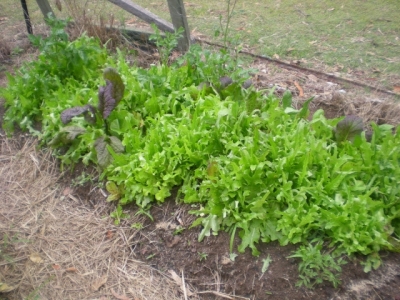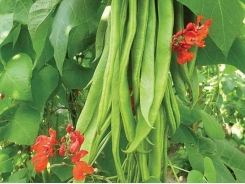Lettuce Varieties – How to Grow Lettuce Plant

How to Grow a Salad : Lettuce Plant
The basis of almost any salad is the lettuce, which can be grown anywhere in the British Isles. In a rather off-putting way, a salad could be compared to a compost heap in that anything organic can go into it and once, when I made a huge salad in the afternoon for evening use, it actually heated up.
Apart from the recognised ingredients of a salad, nearly anything goes: blanched dandelions, beetroot, cucumbers, cress, tomatoes, small cherry tomatoes, cold peas, beans and potatoes. If you are partial to potato salads some of the continental varieties are useful as they remain firm when diced or sliced cold. Try any of the following varieties cooked in the normal way: Aura, Eigenheimer, Etoile de Nord, Fir Apple, Jersey Royal, Kipfler, Purple Congo, Red Craig’s Royal, Red Cardinal.
As most are early varieties they can also be grown in pots in a warm greenhouse or a cold frame.
Lettuce Plant
The lettuce, with the assistance of cloches, cold frames, plastic tunnels or any primitive shelter, can be grown for use for at least nine months of the year. If you can be bothered, it can be grown indoors too in pots, trays or boxes. There has, I think, been more development and new varieties added to lettuces than to any other crop. Many old favourites with household names have had to give way to strange-sounding continental varieties such as Magiola, Novaran or Hilde. No longer is there just the sharp division between the soft cabbage lettuce and the tall crisp cos but many variations in between, including the crinkly and the buttercrunch type.
It is claimed that there are more vitamins in the green leaf than in the blanched crisp heart, although my personal taste is for the solid heart of a variety like Webb’s Wonderful or the crisp nutty flavour of the reddish-brown variety Continuity. However, in the small garden the buttercrunch or non-hearting types are probably better value. These will last for months and can be picked almost daily.
Continuity is one of the best varieties for use early in the season as its young leaves are very dark and not easily seen by sparrows. This is a big advantage, particularly in town gardens where a batch of this variety will be left alone whilst most others may be completely decimated by birds, especially in early spring. The flavour, incidentally, is excellent.
Raising Lettuce Plants
There are several ways of doing this. They may be raised in gentle heat, in boxes or pots and pricked out, raised in frames in containers or sown direct into the frame and planted out directly into the soil when it warms up. The soil should have a good tilth, contain plenty of organic matter and be firm but not hard; lettuce needs moisture and extra watering during periods of drought.
The essence of lettuce production is little and often, bearing in mind that transplanting lettuces adds 10 to 14 days to the time they take to mature. This is important as a small quantity may be sown in a drill and, when large enough to handle, thinned out and selected plants left without further disturbance. Those remaining will mature a week or 10 days earlier than the transplanted ones.
There is no need to drill lettuce seeds right across a plot. Just allocate the space for a row of lettuce plants and sow a drill about a yard long. When large enough thin out and use the thinnings to almost complete a row leaving about another 2 feet for sowing a little more seed. This technique can be adopted in most districts from about mid-March to mid-July. No seedling should be transplanted after the end of July. Covering with a cloche at the beginning of the season can advance the sowing date by a fortnight or three weeks and extend the cutting period at the other end of the season by five or six weeks.
Lettuce Pests
Probably the worst pest is the root aphid which attacks the roots under ground and its presence is not suspected until the plant begins to look pale and sick. It is more prevalent during a dry spell. Watering with an insecticide such as malathion will give effective control in most cases.
Lettuce Varieties
Fortunately the lettuce has been cleaned up and now most lettuce varieties are free from lettuce mosaic virus. Varieties of lettuce like Avon Crisp are resistant to mildew and the variety Irma has a high resistance to bad weather conditions and is slow to bolt. The lettuce varieties Reskia and Sanno Mosaic Tested are also disease resistant. For the tiny garden, for the front of the herbaceous or flower border, window boxes and balcony gardens, the variety Tom Thumb is the best.
The lettuce seedlings can be planted a few inches apart and will make beautiful little hearts. Strangely enough, cos or tall lettuce are popular on the table but not so popular in the garden. There has been less change in these lettuce varieties than amongst all the other types of lettuce and Density, Little Gem, Lobjoit’s Green and Vaux’s Self Folding still dominate. As the latter grows tall and curves its leaves inwards there is always a risk that greenfly will establish itself inside these protective leaves and make them virtually inedible.
In windy areas cos lettuce plants may have to be staked and, unless a self-folding variety is grown, may even have to be tied to prevent them opening out and sprawling.
GENERAL CARE
When the weather is dry, water with a square-area rainer for an hour once a week, to keep the lettuces growing, or water well with the rose on the watering-can. Thin the plants out early to 9 in. apart so that there is never any check to growth. Small varieties like Tom Thumb need be thinned to only 6 in. apart.
HARVESTING
Cut fully-hearted lettuces first thing in the morning while the dew is still on them. Use a sharp knife and make the cut just below the bottom leaves. Never leave plants in the rows once they have started to bolt or they will go to seed. If too many lettuces are ready together put those not required on the compost heap where they will help to rot down other material.
RECOMMENDED SUMMER CABBAGE VARIETIES:
All the Year Round, very hardy and particularly resistant to dry weather conditions. Medium-sized, solid and tender.
Borough Wonder, may be sown in spring or summer. Solid hearts; pale green colour.
Continuity, very long standing, excellent for dry, light soils. Leaves have a reddish-brown tinge which may be considered unattractive.
Great Lakes, a particularly flavorous kind with crisp, crinkly foliage. Stands well in hot weather. Very large.
Iceberg, leaves crimped and fringed. Light green but tinged with a reddish-brown. A good summer dry-weather variety.
Salad Bowl, a loose-leaved variety, of medium green colour. Does not produce a heart.
RECOMMENDED WINTER CABBAGE VARIETIES :
Arctic King, rather small, with solid hearts and few outside leaves. Very early and extremely hardy.
Imperial, large, hardy variety. Fine quality, medium hearts.
Tom Thumb, small compact, dark green hearts. Long standing. May’ be grown in the summer also. Good for small gardens.
Winter Crop, very hardy and suitable for the north. Solid hearts.
Winter Marvel, clear green, slightly wavy leaves. Hardy. Good in the east.
HARVESTING
Cut the lettuces as they are ready in May and June.
Có thể bạn quan tâm
Phần mềm

Phối trộn thức ăn chăn nuôi

Pha dung dịch thủy canh

Định mức cho tôm ăn

Phối trộn phân bón NPK

Xác định tỷ lệ tôm sống

Chuyển đổi đơn vị phân bón

Xác định công suất sục khí

Chuyển đổi đơn vị tôm

Tính diện tích nhà kính

Tính thể tích ao hồ




 Growing Turnips – Swedes and Turnips
Growing Turnips – Swedes and Turnips  Expert Tips – How to Grow Runner Beans…
Expert Tips – How to Grow Runner Beans…